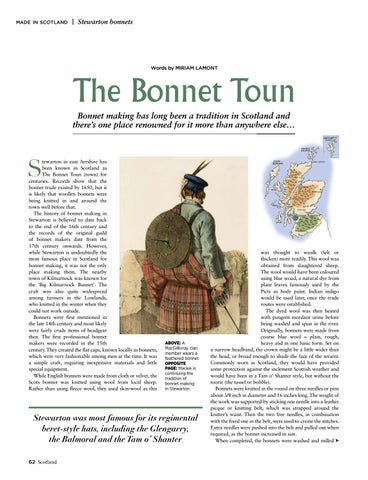made in scotland
| Stewarton bonnets
Words by MIRIAM LAMONT
The Bonnet Toun Bonnet making has long been a tradition in Scotland and there’s one place renowned for it more than anywhere else…
S
tewarton in east Ayrshire has been known in Scotland as The Bonnet Toun (town) for centuries. Records show that the bonnet trade existed by 1650, but it is likely that woollen bonnets were being knitted in and around the town well before that. The history of bonnet making in Stewarton is believed to date back to the end of the 16th century and the records of the original guild of bonnet makers date from the 17th century onwards. However, while Stewarton is undoubtedly the most famous place in Scotland for bonnet making, it was not the only place making them. The nearby town of Kilmarnock was known for the ‘Big Kilmarnock Bunnet’. The craft was also quite widespread among farmers in the Lowlands, who knitted in the winter when they could not work outside. Bonnets were first mentioned in the late 14th century and most likely were fairly crude items of headgear then. The first professional bonnet makers were recorded in the 15th century. They created the flat caps, known locally as bonnets, which were very fashionable among men at the time. It was a simple craft, requiring inexpensive materials and little special equipment. While English bonnets were made from cloth or velvet, the Scots bonnet was knitted using wool from local sheep. Rather than using fleece wool, they used skin-wool as this
ABOVE: A MacGillivray clan member wears a feathered bonnet OPPOSITE PAGE: Mackie is continuing the tradition of bonnet making in Stewarton
Stewarton was most famous for its regimental beret-style hats, including the Glengarry, the Balmoral and the Tam o’ Shanter 62 Scotland
was thought to waulk (felt or thicken) more readily. This wool was obtained from slaughtered sheep. The wool would have been coloured using blue woad, a natural dye from plant leaves famously used by the Picts as body paint. Indian indigo would be used later, once the trade routes were established. The dyed wool was then heated with pungent mordant urine before being washed and spun in the river. Originally, bonnets were made from course blue wool – plain, rough, heavy and in one basic form. Set on a narrow headband, the crown might be a little wider than the head, or broad enough to shade the face of the wearer. Commonly worn in Scotland, they would have provided some protection against the inclement Scottish weather and would have been in a Tam o’ Shanter style, but without the toorie (the tassel or bobble). Bonnets were knitted in the round on three needles or pins about 3/8 inch in diameter and 16 inches long. The weight of the work was supported by sticking one needle into a leather picque or knitting belt, which was strapped around the knitter’s waist. Then the two free needles, in combination with the fixed one in the belt, were used to create the stitches. Extra needles were pushed into the belt and pulled out when required, as the bonnet increased in size. When completed, the bonnets were washed and milled
















